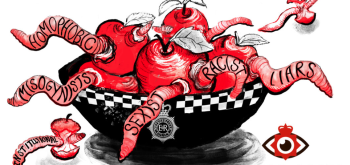In 1996 Gambian asylum seeker Ibrahima Sey died at Ilford police station after being restrained by a number of policemen for a prolonged period of time. An inquest, held a year later, heard evidence of how the 29-year-old, who was suffering from an acute bout of mental illness, was sprayed with CS gas and then restrained face down in the prone position for 15 minutes until he had stopped breathing.
During the course of the hearing, a Home Office pathologist suggested that Sey had suffered some kind of sudden death purely as a result of his mental illness; a condition from the United States known as ‘excited delirium.’
The term is a medically unproven and highly contentious diagnosis which is not recognised by the World Health Organisation or any other international authority. It states that the victim would have died as a result of their excited state induced by drugs or mental illness even if they had not been restrained by officers. This seminal case was to be the first of many in which the diagnosis, otherwise known as ‘sudden-in-custody-death-syndrome’, would be put forward to explain a restraint-related death in the UK.
Research by the Bureau of Investigative Journalism published earlier this month discovered that the term has been used to explain 10 restraint-related deaths in England and Wales since the late 1990s. It has also been put forward by pathologists in at least seven other cases, including that of Ibrahima Sey.
This temporal relationship between excited delirium and a death following restraint has led critics to suggest that it is being used by authorities to mask the culpability of police officers and prison guards.
At the vanguard of the research is Dr Deborah Mash, a neurologist at the University of Miami, who has analysed the brain tissue of suspected excited delirium victims. Her work reinforces the fact that such deaths mainly occur following restraint, According to a paper published in 2009, only three of the 90 excited delirium cases documented by Dr Mash occurred outside of police custody.
In 1998 a review published by a group of US academics found that in 21 US cases of unexpected deaths in people suffering excited delirum — 18 of which were people in police custody — all ‘suddenly lapsed into tranquility shortly after being restrained’. In each of the 21 cases, the victims had been restrained either face-down or through pressure applied to their necks. A 2008 Amnesty International study also found that 111 of the 334 post taser deaths in the US were blamed on excited delirium.
One case was polish immigrant Robert Dziekanski, who died in 2008 after being restrained and tasered by Canadian police at Vancouver airport. Video footage captured on a mobile phone by a concerned witness, showed the 46-year-old being repeatedly tasered as he lay on the ground. Moments before the officers stormed in and reached for their stun guns, Dziekanski can be seen acting in an agitated way, clearly distressed, confused and undergoing an acute bout of psychosis. At the inquest it was suggested by the Canadian police that Dziekanski had been suffering from excited delirium.
Cover up
A two-year long official inquiry into his death led by retired judge Thomas Braidwood concluded that the term was uniformly rejected by medical professionals and was being used as an excuse to cover up actual causes of deaths in custody especially those involving excessive restraint and Taser use.
Braidwood suggested that it was ‘not helpful to characterise people displaying these behaviours as suffering from excited delirium. Doing so implies that excited delirium is a medical condition or diagnosis, when mental health professionals uniformly reject that suggestion.’
Last year a group of UK-based pathologists reviewed the scientific evidence on excited delirium as part of an independent advisory panel into deaths in custody. They concluded that there is a lack of valid research into the concept, suggesting that it is a term mostly used by the police.
It begs the question, of why such a questionable diagnosis has been used in UK coroners’ courts for the past two decades, and why it is still being used by forensic pathologists and police defence lawyers to explain a death at the hands of the state.
Leading forensic pathologist Dr Nat Cary, told me that the term has gained traction because restraint deaths are notoriously hard to determine at autopsy. ‘These cases are difficult and there is no standard protocol by which it should be done. It is not difficult for an individual to die with very few marks on their body because all you are doing is compressing a few things which leaves a lack of bruising.
Excited Delirium was being used as ‘a catch-all diagnosis’ to explain away a death, he said. ‘It is a diagnosis of exclusion used when there is anecdotal evidence that a patient was behaving bizarrely or was on drugs. In every excited delirium case that I have come across the individual is restrained in a prone position, for a prolonged period of time, by a number of officers.’
The jury at the inquest into Ibrahim Sey delivered an unlawful killing verdict, rejecting the police’s defence that he had died as a result of his mental illness. His death was, they suggested, due to the nature and extent of the ‘unreasonable and unnecessary force.’
They were fortunate. Other families have had the deaths of their loved ones blamed on a spurious and unproven diagnosis that places the weight of culpability back onto the victim.
Following the loss of a loved one at the hands of the state, the family relies on the inquest to answer important questions about the death and to hold to account restraint practices that could be improved in the future. In all too many of these cases terms such as excited delirium have meant that important questions about the nature of police restraint are not answered as directly and as thoroughly as they should be.










